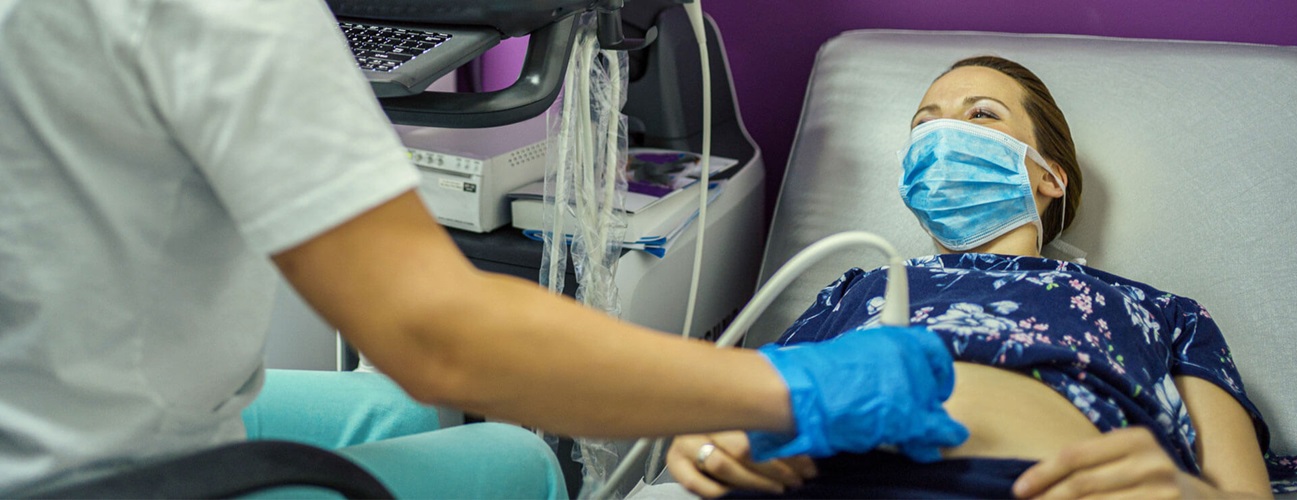First Trimester Screening, Nuchal Translucency and NIPT
First trimester screening (FTS), nuchal translucency (NT) and noninvasive prenatal testing (NIPT) are prenatal tests that provide information on a developing baby’s risk for certain chromosomal differences (anomalies).
The screening is a blood test that evaluates substances in the blood (analytes), and NT is a sonogram that looks at nuchal translucency in the back of the fetal neck. Noninvasive perinatal testing (NIPT) is a newer method that provides a result with a blood test only; a first trimester ultrasound is still recommended.
FTS, NT and NIPT provide data that can help assess if a fetus (developing baby) has one of three genetic anomalies:
- Down syndrome
- Trisomy 13
- Trisomy 18
These tests cannot diagnose these anomalies. But the data they provide help assess the likelihood that a fetus may have one of these conditions.
What You Need to Know
- The first trimester screening test (FTS) is blood work, and the nuchal translucency test is specialized imaging of the fetus using ultrasound.
- When the two tests are performed together, the combined data can help assess the risk of certain genetic conditions, but it cannot diagnose them.
- Noninvasive prenatal testing, or NIPT, is a new option that uses a blood test to look for signs of Down syndrome, trisomy 13 and trisomy 18 by analyzing free fragments of DNA in the bloodstream.
What is combined first trimester screening?
This is available to pregnant people from weeks 11 through 13 of pregnancy. It comprises a maternal blood test and a nuchal translucency test, which is ultrasound imaging of the fetus to look for clues that could affect the chances of certain genetic conditions. The test may be accompanied by genetic counseling.
The nuchal translucency ultrasound portion of combined first trimester screening is performed by specially credentialed sonographers.
FTS is not a diagnostic test, which means it cannot tell you for certain whether the fetus has Down syndrome, trisomy 13 or trisomy 18. Instead, the screening helps measure the probability that a fetus might have one of these conditions. Data from the ultrasound and blood test, together with the mother’s age, can provide information about whether the fetus is at an increased risk for one of these chromosomal disorders.
If the combined first trimester screening data show that there is a 1 in 250 chance ― or greater ― that the developing fetus has one of these conditions, your doctor may recommend further testing to rule them out.
What is noninvasive prenatal testing (NIPT)?
NIPT is a different approach for identifying the risk that a fetus is affected by Down syndrome, trisomy 13 or trisomy 18. It consists of a blood test alone. A nuchal translucency ultrasound can still be performed, and it will not affect the NIPT results. Noninvasive prenatal testing can pick up tiny pieces of DNA in the mother’s bloodstream and analyze them for factors that would raise the risk of the fetus having a chromosomal difference.
In addition to Down syndrome and trisomies 13 and 18, NIPT can detect clues associated with other abnormal chromosomes, such as Turner syndrome, Klinefelter syndrome and triple X syndrome. NIPT can also predict the fetus’s sex with high accuracy.
Nuchal translucency and NIPT: Why are they performed?
Down syndrome, trisomy 13 and trisomy 18 are chromosomal disorders that cause intellectual disability and birth defects in children who are born with them. Anyone can have a baby with these chromosomal abnormalities, but the chance increases with the mother’s age.
Babies with Down syndrome (trisomy 21) have an extra 21st chromosome, which may cause a range of signs and symptoms, including intellectual disability and various medical complications involving the heart, digestive tract and other organ systems.
Trisomy 18 (having an extra 18th chromosome) and trisomy 13 (having an extra 13th chromosome) are more severe disorders that cause profound intellectual disability and severe birth defects in many organ systems. Sadly, few babies with trisomies 13 or 18 survive more than a few months.
Preparing for First Trimester Screening
These screenings include a simple blood test, with or without ultrasound. Neither the blood test nor the ultrasound is invasive, so no special preparations are necessary.
What happens during combined FTS?
The blood test part of the test takes a sample of the mother’s blood. The sample is analyzed to check levels of three chemicals to see if they are higher or lower than average, which can indicate a higher or lower chance of Down syndrome, trisomy 13 or trisomy 18:
- Free beta-human chorionic gonadotropin (hCG)
- Pregnancy-associated plasma protein-A (PAPP-A)
- Alpha-fetoprotein (AFP)
The nuchal translucency will examine:
- The progress of your pregnancy
- The fluid underneath the skin along the back of the fetus’s neck, called the nuchal translucency, or nuchal fold. In some pregnancies, when the fetus has Down syndrome, trisomy 13 or trisomy 18, there is extra fluid behind the neck. A larger-than-expected nuchal fold is associated with other birth defects such as congenital heart defects and skeletal problems.
- Presence of the fetus’s nasal bone. While a nasal bone may be absent in some fetuses with a chromosomal abnormality, most with this finding are normal.
Combining your age-related risk with the nuchal translucency measurement, nasal bone data and bloodwork provides one risk result for Down syndrome and a separate risk result for trisomy 13 or trisomy 18. Your obstetrician will get your screening results in about one week.
How accurate is FTS?
Because these are screening tests, a positive result (showing an increased risk) does not mean that your baby has one of these conditions. It indicates that further diagnostic tests are options for you to consider. Also, a negative or normal result (one that shows a decreased risk) does not mean a chromosomal abnormality is definitely not present.
The combined first trimester screening’s detection rate is approximately 96% for pregnancies in which the baby has Down syndrome, and it is somewhat higher for pregnancies with trisomy 13 or trisomy 18. A nuchal translucency ultrasound can be performed without the bloodwork, but the detection rate is reduced to about 70%.
This screen is not designed to provide information about the possibility of other chromosomal conditions, but it does have limited utility for screening for some other genetic syndromes, genetic disorders and birth defects.
For NIPT, the detection rate depends on the laboratory, but for high-risk mothers pregnant with one baby, the accuracy rate ranges between 90% and 99%, with false positive rates of less than 1%.
What if the screening shows an increased risk for one of the conditions?
If the screening results indicate that your baby is at an increased risk for Down syndrome or trisomy 13 or 18, this does not mean that one of these conditions is present, but this information can help your doctor decide whether further testing is right for you.
A genetic counselor is available to go over your results and to discuss additional screening and testing options, such as chorionic villus sampling (CVS) and amniocentesis. CVS and amniocentesis are more invasive diagnostic procedures that detect a chromosomal abnormality with greater than 99% accuracy.
What is a quad screen?
The second trimester maternal serum screening test, also known as the quad screen, is performed between 16 and 20 weeks, and measures chemicals in the mother’s blood. Like the first trimester screening, results from a second trimester quad screen can be used to statistically adjust a woman’s age-related risk for Down syndrome and trisomy 18 (but not trisomy 13).
In addition, the alpha-fetoprotein (AFP) portion of the screen in the second trimester can identify pregnancies at an increased risk for open neural tube defects such as spina bifida. Quad screening is not recommended if combined first trimester screening has already been performed. However, AFP can be drawn as an independent test to screen for spina bifida.






